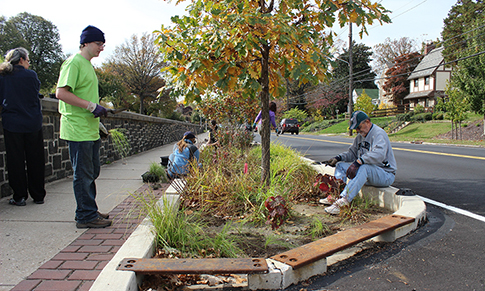
Soak It Up! Adoption volunteers take care of street trees in an East Falls bumpout. Stormwater tree planters, tree trenches, and rain gardens are just some of our green tools that commonly incorporate trees. Photo credit: Philadelphia Water.
We came across an interesting read recently that looks at a study in Toronto that sought to determine the economic and health benefits associated with trees in urban settings. Here's a summary of the study that appeared in a July 23 New Yorker article titled "How Trees Calm Us Down":
"... a new study in the journal Scientific Reports by a team of researchers in the United States, Canada, and Australia, led by the University of Chicago psychology professor Marc Berman ... compares two large data sets from the city of Toronto, both gathered on a block-by-block level; the first measures the distribution of green space, as determined from satellite imagery and a comprehensive list of all five hundred and thirty thousand trees planted on public land, and the second measures health, as assessed by a detailed survey of ninety-four thousand respondents. After controlling for income, education, and age, Berman and his colleagues showed that an additional ten trees on a given block corresponded to a one-per-cent increase in how healthy nearby residents felt."
One percent? Doesn't sound like much, does it? But here's the quote that blew us out of the water:
"To get an equivalent increase with money, you’d have to give each household in that neighborhood ten thousand dollars—or make people seven years younger," Berman told the article's author, Alex Hutchinson.
Who wouldn't like to get their hands on an $10,000, let alone feel seven years younger?
Because so many of our Green City, Clean Waters projects use trees to either help soak up stormwater or improve overall renovations, this study made us wonder just how many new trees Green City, Clean Waters is bringing to the city.
Here's what we found:
|
Status
|
SMP* Trees
|
Non SMP Trees
|
New Trees
|
|
Constructed
|
1085
|
740
|
1825
|
|
Designed
|
150
|
96
|
246
|
|
In Construction
|
99
|
47
|
146
|
|
Total
|
1334
|
883
|
2217
|
"SMP" stands for Stormwater Management Practice. Note: because the "designed" figure could change, this should be considered an estimate.
That's a lot of trees, right? And, by the calculations of this study, if there's just one household for every 10 Green City, Clean Waters trees, they would be making those households feel a collective 1,552 years younger or $2,217,000 ($2.2 million) richer. Of course, there are many more households than that in the neighborhoods improved by Green City, Clean Waters trees, so the exact benefits are much harder to tally. But the impact is clearly huge.
That's just in the first four years of the 25-year Green City, Clean Waters plan. We still have another two decades of greening ahead of us, and we're really looking forward to a much greener Philly with even healthier rivers in 2036!